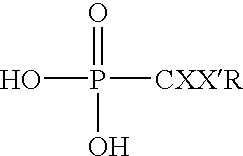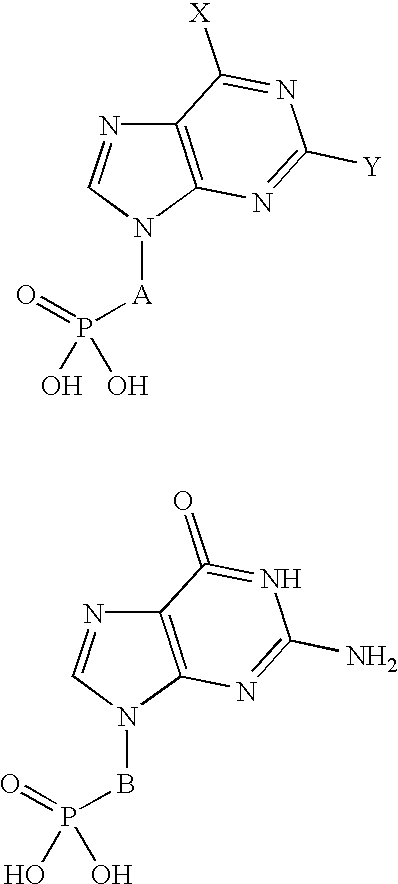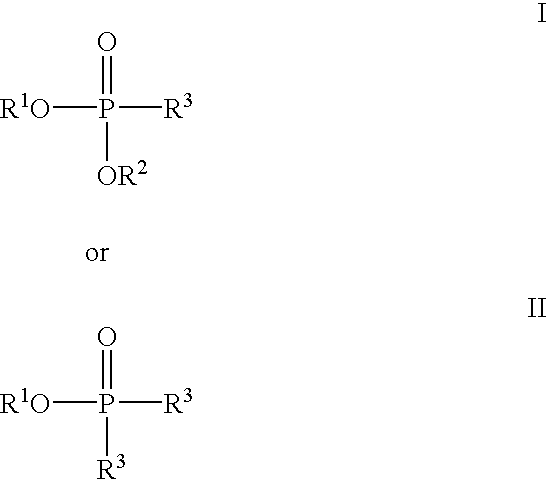Methods for the dealkylation of phosphonate esters
a technology of phosphonate esters and dealkylation reagents, which is applied in the field of antiviral agents, can solve the problems of poor reactivity of compounds, sterically impractical and/or synthetically non-feasible, and the use of trimethylchlorosilane as a dealkylation reagent in reactions with phosphonate esters is hindered by poor reactivity
- Summary
- Abstract
- Description
- Claims
- Application Information
AI Technical Summary
Problems solved by technology
Method used
Image
Examples
example 1
This example assesses the ability of TMSCl to cleave a variety of phosphonate esters using a solvent and a sealed reaction vessel according to reaction (1) below: ##STR10##
Specifically, 1.0 M solutions of 1 in chlorobenzene were mixed with TMSCl in sealed glass pressure tubes and heated at temperatures ranging from 130-140.degree. C. As substitution to 2 progressed, modest increases in the internal pressure of the reaction vessels were observed due to the formation of volatile alkylchloride. The pressure reached a maximum at reaction completion, then returned to atmospheric pressure on cooling back to room temperature.
The conversions of 2 to phosphonic acids 4 were monitored by evaporating an aliquot of the reaction mixture, adding D.sub.2 O and observing the resulting formation of phosphonic acids 4 by .sup.1 H and .sup.31 P NMR.sup.4 (Table III).
As per Table III, phosphonate esters containing several functional groups were evaluated for ease of dealkylation and compatibility to th...
example 2
This example illustrates dealkylation of two specific phosphonate esters. Specifically, PMEA 7 and PMPA 8 are broad spectrum antivirals including potent and selective activity against human immunodefficiency virus..sup.2,3 One reported synthesis of 7 and 8 utilizes TMSBr for cleavage to the phosphonic acids from the diethylesters 5 and 6..sup.2
By comparison, the same deprotections were performed with TMSCl (reaction 2) affording 7 and 8 in equivalent yields and purities as those obtained with TMSBr. The ease in which 5 and 6 are deprotected with TMSCl in chlorobenzene is in striking contrast to deprotection by heating with TMSCl alone, which is reported in the literature not to be effective in deprotecting adenosine diethylphosphonates.sup.11.
Reaction (2) is illustrated below: ##STR11##
Specifically, diethyl PMEA 5 (41.1 g, 0.125 mol) and chlorobenzene (0.125 L) were charged to a 1L ACE.TM. glass pressure reactor (available from Ace Glass, Inc.) containing a thermowell and a pressure...
PUM
| Property | Measurement | Unit |
|---|---|---|
| boiling point | aaaaa | aaaaa |
| dielectric constant | aaaaa | aaaaa |
| dielectric constant | aaaaa | aaaaa |
Abstract
Description
Claims
Application Information
 Login to View More
Login to View More - R&D
- Intellectual Property
- Life Sciences
- Materials
- Tech Scout
- Unparalleled Data Quality
- Higher Quality Content
- 60% Fewer Hallucinations
Browse by: Latest US Patents, China's latest patents, Technical Efficacy Thesaurus, Application Domain, Technology Topic, Popular Technical Reports.
© 2025 PatSnap. All rights reserved.Legal|Privacy policy|Modern Slavery Act Transparency Statement|Sitemap|About US| Contact US: help@patsnap.com



